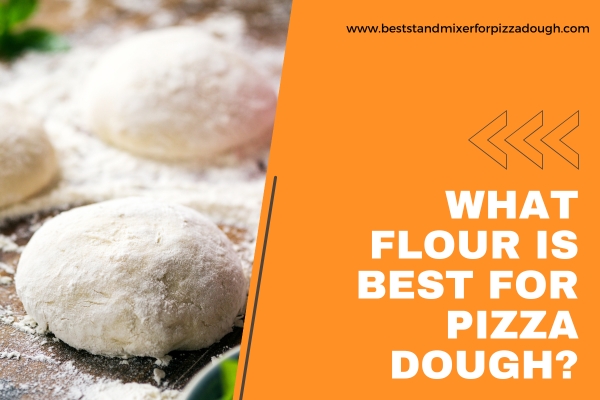When it comes to creating the perfect pizza, every ingredient plays its part. But, perhaps none is as crucial as the foundation of your pie—the dough. The type of flour you use can significantly impact the texture, flavor, and overall quality of your pizza. This guide aims to demystify the process of selecting the right flour for your pizza dough, helping you achieve that authentic pizzeria experience in your own kitchen.
More Articles: Best Stand Mixer for Pizza Dough
The Foundation of Flavor: Choosing Your Flour
The journey to pizza perfection begins with selecting the right flour. Flour is not just a base but a cornerstone that influences the dough’s chewiness, elasticity, and ability to rise. With so many types available, how do you make the right choice?
Unraveling the Types of Flour
Understanding the different types of flour is the first step in making an informed decision. Here’s a breakdown:
All-Purpose Flour
Widely available and versatile, all-purpose flour is a go-to for many home cooks. It has a moderate protein content (around 10-12%), making it suitable for various recipes, including pizza dough. While it may not yield the same elasticity as higher-protein flours, it still produces a satisfactory crust.
Bread Flour
With a higher protein content (around 12-14%) than all-purpose flour, bread flour is ideal for those who want a chewier, more elastic dough. The increased gluten formation helps the dough rise better and creates a more robust structure, resulting in a crust that’s crispy on the outside yet soft and airy on the inside.
Tipo 00 Flour
Favored by Italian pizzerias, Tipo 00 flour is finely ground with a protein content similar to that of bread flour. It produces a dough that’s incredibly smooth and elastic, making it perfect for thin-crust pizzas. The fine grind allows for better hydration and a more refined texture, setting the stage for an exquisite Neapolitan-style pizza.
Whole Wheat Flour
For those looking to add more nutrients and a slightly nutty flavor to their dough, whole wheat flour is an excellent option. It contains more fiber and nutrients than white flours but has a lower gluten content, which can result in a denser dough. Mixing it with bread flour can help balance texture and nutritional value.
The Science Behind Yeast and Gluten Development
Understanding how yeast and gluten work can help you master the art of pizza dough. When flour mixes with water, gluten proteins form a network that gives the dough its structure. Yeast acts as a leavening agent, producing carbon dioxide that gets trapped within the gluten network, causing the dough to rise.
Higher-protein flours like bread flour and Tipo 00 provide more gluten, leading to a chewier texture and better rise. Conversely, lower-protein flours result in a softer, more tender crust.
Perfecting Hydration Ratios
Hydration, the ratio of water to flour in your dough, is another critical element. A higher hydration level (70% and above) results in a dough that’s more elastic and easier to stretch, producing a lighter, airier crust. Lower hydration levels create a denser dough, which can be challenging to work with but yields a sturdier crust.
Kneading Techniques That Make a Difference
Kneading is essential for developing the gluten network in your dough. Whether you prefer to knead by hand or use a stand mixer, the goal is to achieve a smooth, elastic ball of dough. Over-kneading can make the dough tough, while under-kneading will result in a weak structure.
By Hand
Kneading by hand allows you to feel the dough’s development. Use a push-fold-turn technique: push the dough away, fold it back on itself, and turn it 90 degrees. Repeat this process for 8-10 minutes until the dough is smooth and elastic.
Using a Stand Mixer
If you prefer using a stand mixer, mix the ingredients on low speed until combined, then increase to medium speed and knead for 5-7 minutes. The dough should pull away from the sides of the bowl and form a cohesive ball.
Age Matters: Resting and Fermenting Your Dough
Resting and fermenting your dough can make a significant difference in flavor and texture. Allowing the dough to rest gives the gluten time to relax, making it easier to shape.
Bulk Fermentation
After kneading, let the dough rise at room temperature for 1-2 hours until it doubles in size. This initial fermentation helps develop the dough’s flavor.
Cold Fermentation
For a deeper flavor, try cold fermentation by placing the dough in the refrigerator for 24-72 hours. This slow fermentation process allows the yeast to work more gradually, enhancing the dough’s complexity and making it easier to digest.
Exploring Different Types of Flour for Homemade Pizza Dough
To help you make an informed decision, let’s take a closer look at how different flours affect your pizza dough:
All-Purpose Flour
- Pros: Versatile, readily available
- Cons: Moderate gluten content may result in less chewiness
- Best For: Quick and convenient pizza nights
Bread Flour
- Pros: High gluten content, chewy texture, good rise
- Cons: Slightly denser and heavier crust
- Best For: New York-style and pan pizzas
Tipo 00 Flour
- Pros: Fine grind, high gluten content, smooth and elastic dough
- Cons: Can be more expensive and harder to find
- Best For: Neapolitan-style pizzas
Whole Wheat Flour
- Pros: Higher nutritional value, unique flavor profile
- Cons: Lower gluten content, denser dough
- Best For: Health-conscious recipes, mixed with other flours for balance
Conclusion: Your Path to Perfect Pizza Dough
Creating the perfect pizza dough starts with choosing the right flour. Whether you opt for the versatility of all-purpose flour, the chewiness of bread flour, the finesse of Tipo 00, or the nutritional benefits of whole wheat, understanding the properties of each will help you make an informed choice. Coupled with the right kneading techniques, hydration levels, and fermentation methods, you’re well on your way to mastering the art of homemade pizza.
Experimenting with different flours and techniques can be a fun and rewarding journey, leading you to discover your perfect pizza dough recipe. So, roll up your sleeves, dust off your apron, and get ready to create some deliciously unforgettable pizzas!

